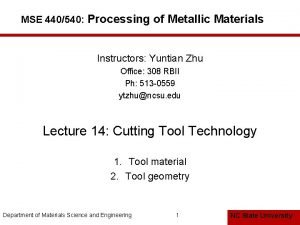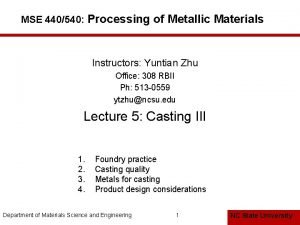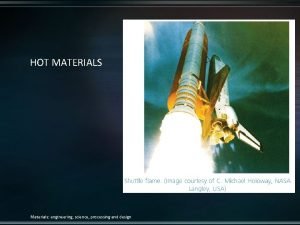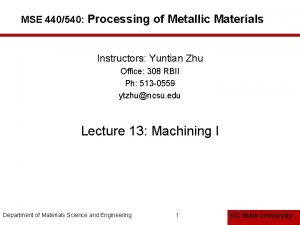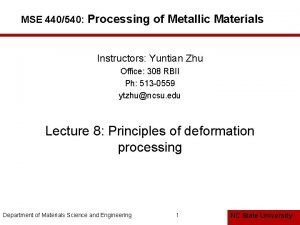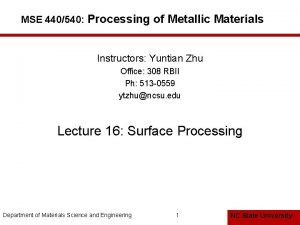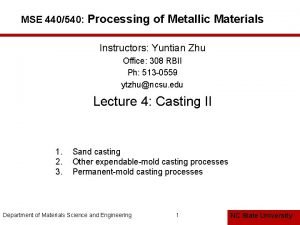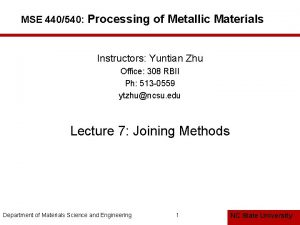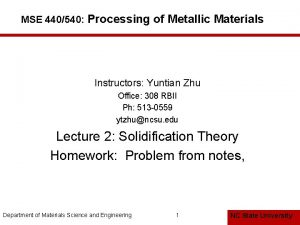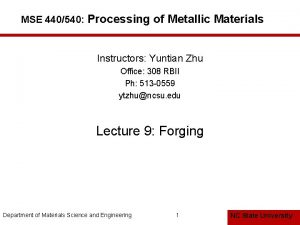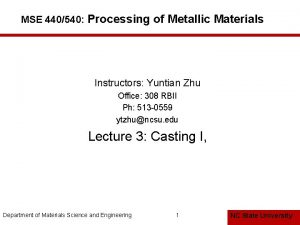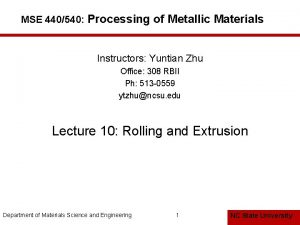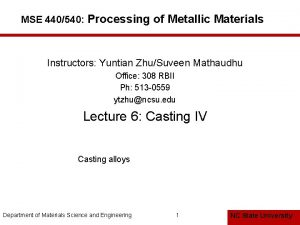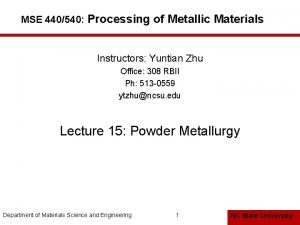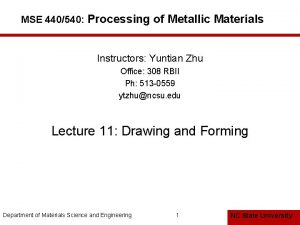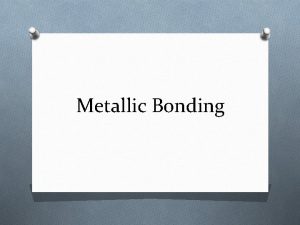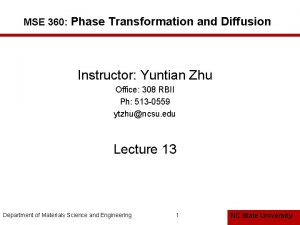MSE 440540 Processing of Metallic Materials Instructors Yuntian

















- Slides: 17

MSE 440/540: Processing of Metallic Materials Instructors: Yuntian Zhu Office: 308 RBII Ph: 513 -0559 ytzhu@ncsu. edu Lecture 12: Cutting (Shearing) and Bending Department of Materials Science and Engineering 1 NC State University

Sheet Metalworking Terminology • Punch‑and‑die - tooling to perform cutting, bending, and drawing • Stamping press - machine tool that performs most sheet metal operations • Stampings - sheet metal products (1) Just before punch; (2) punch pushes into work, causing plastic deformation; (3) punch penetrates into work; and (4) fracture is initiated NC State University

Shearing, Blanking, and Punching • Three principal operations in pressworking that cut sheet metal: – Shearing (cutting) – Blanking – Punching NC State University

Blanking and Punching • Blanking (a) - sheet metal cutting to separate piece (called a blank) from surrounding stock • Punching (b) - similar to blanking except cut piece is scrap, called a slug NC State University

Clearance in Sheet Metal Cutting Distance between punch cutting edge and die cutting edge • Typical values range between 4% and 8% of stock thickness – If too small, fracture lines pass each other, causing double burnishing (rubbing) and larger force – If too large, metal is pinched between cutting edges and produces excessive burr (rough edge) C = clearance http: //www. youtube. com/watch? v=VMu 7_W 0 QE 3 Y NC State University

Clearance in Sheet Metal Cutting • Recommended clearance is calculated by: c = at where c = clearance; a = allowance; and t = stock thickness • Allowance a is determined according to type of metal (4 -8%) NC State University

Sheet Metal Groups Allowances Metal group 1100 S and 5052 S aluminum alloys, all tempers 2024 ST and 6061 ST aluminum alloys; brass, soft cold rolled steel, soft stainless steel a 0. 045 Cold rolled steel, half hard; stainless steel, half hard and full hard 0. 075 0. 060 Softer metals have smaller allowances NC State University

Angular Clearance • Purpose: allows slug or blank to drop through die • Typical values: 0. 25° to 1. 5° on each side NC State University

Cutting Forces • Important for determining press size (tonnage) F=St. L where S = shear strength of metal; t = stock thickness, and L = length of cut edge NC State University

Sheet Metal Bending Metal on inside of neutral plane is compressed, while metal on outside of neutral plane is stretched a NC State University

Bend Allowance Formula • Problem: to determine the length of neutral axis of the part before bending ‘ where Ab = bend allowance; α = bend angle; R= bend radius; t = stock thickness; and Kba is factor to estimate stretching • If R < 2 t, Kba = 0. 33 • If R ≥ 2 t, Kba = 0. 50 (middle line) R NC State University

V-Bending • (1) Before bending • (2) After bending • Application notes: – Low production – Performed on a press brake – V-dies are simple and inexpensive NC State University

Edge Bending • (1) Before bending • (2) After bending • Application notes: – High production – Pressure pad required – Dies are more complicated and costly http: //www. youtube. com/watch? v=W 6 usv. OZ 9 y. Iw NC State University

Springback When bending pressure is removed, elastic energy remains in bent part, causing it to recover partially toward its original shape Plastic + elastic deformation Need overbending to correct NC State University

Bending Force • Maximum bending force estimated as follows: where F = bending force; TS = tensile strength of sheet metal; w = part width in direction of bend axis; and t = stock thickness. For V-bending, Kbf = 1. 33; for edge bending, Kbf = 0. 33, NC State University

Roll Bending • Large metal sheets and plates are formed into curved sections using rolls http: //www. youtube. com/watch? v=J 09 E_lu. T 1 p. M NC State University

HW assignment • Reading assignment: Chapters 15, 16 • Review Questions: 14. 3, 14. 6, 14. 7, 14. 8, • Problems: 14. 1, 14. 2, 14. 3, Department of Materials Science and Engineering 17 NC State University
 Tool material
Tool material 440540
440540 Cone experience
Cone experience Inorganic non metallic materials examples
Inorganic non metallic materials examples Man made map
Man made map Adapting and adopting materials
Adapting and adopting materials Cant stop the feeling go noodle
Cant stop the feeling go noodle Direct materials budget with multiple materials
Direct materials budget with multiple materials Ano ang mga useful materials
Ano ang mga useful materials Materials engineering science processing and design
Materials engineering science processing and design Ns grade 7 term 2 notes
Ns grade 7 term 2 notes Recycling involves taking used materials
Recycling involves taking used materials Bottom up processing vs top down processing
Bottom up processing vs top down processing Histogram processing in digital image processing
Histogram processing in digital image processing Thinning and thickening in image processing example
Thinning and thickening in image processing example Neighborhood processing
Neighborhood processing Bottom up processing example
Bottom up processing example Parallel processing vs concurrent processing
Parallel processing vs concurrent processing
